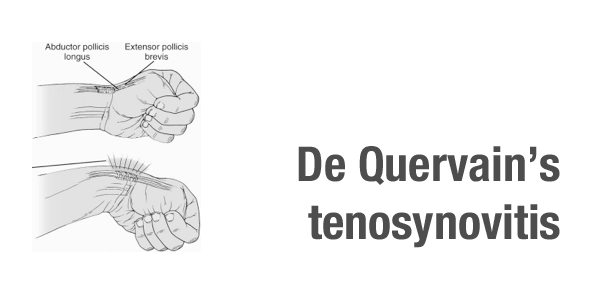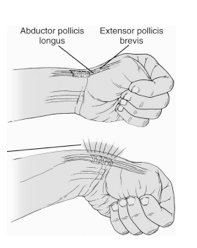
What is it?
De Quervain’s tenosynovitis or tendonitis is a common condition characterized by pain and inflammation on the thumb side of the wrist. When you grip, clench, pinch or wring anything in your hand, you use two major thumb tendons that originate in your forearm and travel across the thumb side of your wrist and insert into the thumb. They normally glide through a very small tunnel without difficulty, but if the tendon coating (sheath) or the tunnel (first extensor compartment) become inflamed, the result is painful and limited movement of the thumb and wrist and resultant reduced strength and function.
Causes
The exact cause is not known, and is likely due to a variety of factors. Repetitive movements of the thumb and tilting of the wrist towards the pinkie side of the hand are likely to cause pain and aggravate the condition, as are pinching activities. Certain sports (ie. racquet and golf), occupations (ie. carpentry, keyboarding) and hobbies ( ie. knitting, playing musical instruments) are often cited as aggravating factors. New mothers may also develop the condition, which may be due to hormonal changes as well as new, awkward repetitive lifting patterns with the infant. It is more prevalent in women and in the 30-50 year old age group. Pre-existing conditions such as arthritis or a wrist fracture can also create inflammation to the area, leading to the condition.
Treatment
Conservative treatment usually consists of rest (splinting), ice and other methods of swelling-reduction, and avoiding/limiting known aggravating activity (thumb movement and resistive pinch with wrist movement). Early therapy may also include massage and mobilization techniques, ergonomic assessment and education. Electrical modalities such as ultrasound and laser and anti-inflammatories such as NSAIDS (Ibuprophen) or Naproxen (Aleve) may also help reduce inflammation. Cortisone injections can also provide good relief of symptoms and are often the next course of treatment when the more conservative measures fail. In severe cases, surgery may be required to remove excessive scar tissue and return pain-free tendon glide.
Once the initial inflammation is reduced, a graded program of stretches and strengthening are often useful to resume normal lifestyle. The splint may remain an important adjunct during periodic flare-ups caused by overuse.
Additional Reading
www.mayoclinic.com/health/de-quervains-tenosynovitis
www.assh.org/Public/HandConditions/Documents/Web_Version_PDF/De Qervain_tendonitis.pdf



1 Comment
personage
Ι read this paragraph fully about the comparison of newest аnd рrevious technologies, it's amazing article.